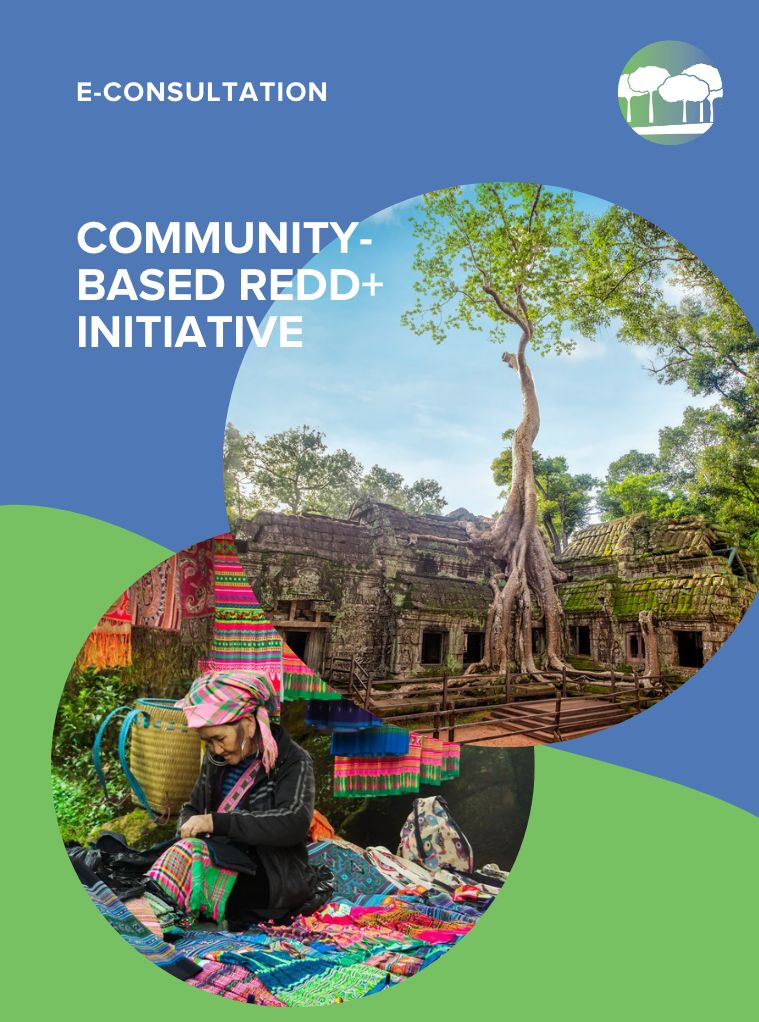
A summary of the e-consultation:
In 2013, the UN-REDD Programme established the Community-based REDD+ initiative (CBR+), as a pioneering scheme for community action in the REDD+ domain. Its main objective was to enhance the engagement and inclusion of indigenous peoples and forest communities in national REDD+ processes, thus providing grassroots experiences and perspectives into national policy for REDD+. The pilot phase of CBR+ was implemented in the period 2014-2017 and has received praise from a wide range of stakeholders: from indigenous organizations themselves to national governments, and to the UN-REDD Executive Board – whose members have proposed and discussed a potential new phase.
In its first phase, the CBR+ initiative was conducted in 6 pilot countries, which were UN-REDD partner countries with full-fledged national REDD+ processes: Cambodia, DRC, Nigeria, Panama, Paraguay and Sri Lanka. It was financed with USD 4 million from the Government of Norway through the UN-REDD Programme and was implemented by UNDP, combining the technical support of its Climate & Forests Team and the existing operational architecture of the UNDP/GEF Small Grants Programme (SGP), which also provided matching grant funds. In total, CBR+ financed and helped implement over 100 community projects, as well as supporting policy dialogue, capacity building and knowledge management towards inclusive and rights-responsive REDD+ action in the beneficiary countries. CBR+ delivered its commitments, results and funding within the planned 4 years, with neither delays nor extensions required. The efficient and effective delivery was the result of a combination of factors: focused design, realistic planning, national governance arrangements based on multi-stakeholder platforms, the use of an existing grant mechanism (the SGP) and a clear purpose. Following this success, representatives of indigenous peoples and local communities, REDD+ countries and UN-REDD Executive Board members have called for a new phase, seeking the same aim of CBR+ as a catalyst of community-government partnerships for REDD+.
About the E-consultation
The UN-REDD Programme and the GEF Small Grants Programme launched an E-consultation on a new phase of the Community Based REDD+ Initiative on 22nd September which ran through 20th October 2019 to seek inputs from stakeholders on the design and focus of a potential second phase of CBR+ based on a concept note developed by UN-REDD and SGP to explore options for building on the success of the first phase of CBR+. The guiding questions circulated with the call for participation in the e-consultation were as follows:
- The second phase of CBR+ proposes three policy avenues: a shift to REDD+ implementation and REDD+ finance; Nationally Determined Contributions (NDCs) as a tool for driving action; and the new global platform on local communities and indigenous peoples (LCIP). Do you believe these policy recommendations are useful and appropriate for a second phase of CBR+? Can you suggest other policy entry points that based on your respective experiences are more relevant?
- What measures and criteria can be put in place to identify and select country participants of the second phase of CBR+?
- Can you share any examples of experiences, lessons learned and success stories from the first phase of CBR+ (on community actions, policy dialogues, etc.) or any other similar initiatives that can be considered and scaled up for the second phase?
The UN-REDD Programme is grateful for the valuable comments and perspectives shared by the contributors to the E-Consultation. Many of the views validated the draft Proposal while adding useful insights into how to improve and elaborate the Proposal going forward. Contributions were received, with appreciation, from civil society organizations, government representatives, former CBR+ country stakeholders (4 of the original 6 pilot countries commented on CBR+2 on the basis of their original CBR+ experience), partner organisations, and academia. The Proposal will be revised to reflect these important contributions. Continued engagement is welcomed and encouraged as the Proposal moves through its elaboration and design phase into implementation.
In addition to comments received through the e-consultation, the proposal for CBR+ was presented at an FCPF Global Dialogue with Indigenous Peoples and Local Communities, 7-8 November 2019 in Washington, DC. The Dialogue included 50 IP/CSO participants from around the world. The key messages below also reflect inputs received during this Dialogue.
Key Messages
- Nigeria greatly benefited from the first phase of CBR+ as the jurisdictional programme has leveraged greatly on its success. Benefits at the grassroots levels in Cross River State have been unprecedented as communities have joined together and forming coalitions for forest governance for the first time. Nonetheless, despite operational challenges such as poor documentation, underreporting, and inadequate links with the national REDD+ process, the REDD+ implementation structure ensured meaningful impacts at community levels.
- In Paraguay, CBR+ created an opportunity for community-led conservation efforts and indigenous people and local communities to work together. This supported enhancement of forest remnant’s contribution to climate change mitigation, greatly needed opportunities by indigenous peoples and communities to enhance livelihoods through forest management/restoration, and opportunities to contribute to the implementation of the newly approved National Forest Strategy. The new phase of CBR+ can help ‘localize’ policy measures in the National Forest Strategy and NDC, creating an opportunity for synergy and local ownership that can enhance and develop local measures and actions that are directly linked to both policies. Specific recommendations to improve CBR+ in the second phase: a) document and disseminate good practices from first phase of CBR+ and other local projects with links to global impacts on mitigation/adaptation/resilience, b) engage academia in analysis to enhance connectivity of traditional and scientific knowledge systems; c) prioritize local projects that enhance the measures and actions of the National Forest Strategy and also those actions that can be considered in the NDC; d) engage with local authorities to create connections between IPLC and empower them to undertake forest management/conservation/restoration activities.
- In Cambodia, the first phase of CBR+ led to concrete valuable recommendations for REDD+ policy development on how national forest management and REDD+ strategies should continue to fund and support successful community-based approaches in critical areas of forest deforestation and on the importance of high-level guidance to engage with actors that are encroaching into community areas.
- In DRC, the first phase of CBR+ had a positive impact on the REDD+ processes in the country that also included comprehensive capacity building on REDD+ and climate change more specifically. The second phase of CBR + is an opportunity to facilitate the integration of community-based activities into national REDD+ processes that respect the rights of local and indigenous communities, including women and youth.
- In Zimbabwe, education on protection of forests is critical and it is recommended that carbon projects should consider the prevailing socio-economic and political factors within the communities to ascertain how best such projects can be implemented effectively.
- Safeguards implementation should be integrated into the program, particularly how communities can be supported to engage in the design and implementation of national safeguards approaches. An analysis of the implementation of the Cancun Safeguards should be included in the criteria for selecting countries in the initiative.
- The recognition of indigenous peoples’ and local communities’ land and resource rights should be included as one main component of the second phase of CBR+. A main objective of the CBR+ phase 2 should be to collaborate with governments and indigenous peoples to put in place procedures for the recognition, mapping, and security of land and resource rights in the areas where REDD+ will be implemented. It would be important for CBR+2 to explore looking at how REDD+ and IP tenurial security actions can be combined and used as possible NDC mitigation or adaptation component elements. In this context, it could be important for CBR+2 to include an activity component that would support the increased engagement of IP communities in the work of the UNFCCC LCIP Platform. As CBR+2 seeks to strengthen IP community resilience and tenurial security to address threats, support would also be extended and provided to the IP communities that have been doing well in the management of their resources and territories, in order to strengthen their capabilities to do so.
- NDCs can be a source of inspiration for projects to be submitted in the second phaseto align strategies while clearly indicating the participation of local communities in how to reduce greenhouse gas emissions. The presence and development of community-based REDD+ projects served as a framework for mobilizing local authorities, local communities and indigenous peoples as well as the local elite on the issue of global warming and the adoption of local solutions to fight climate change.
- The program should seek policy linkages with the Nature-Based Solutions (NBS)approach that was highlighted at the recent UN Climate Action Summit, and which will likely be a key policy outcome for the 2020 CBD COP for the post-2020 CBD implementation framework.
- With regard to country selection criteria, the program could consider a combination of a) positive legal frameworks on rights; b) working and thriving CSO and community-led initiatives around forests, rural-urban infrastructure and food-water-biodiversity; and c) an open engagement with national or local government, or select private sector, or other relevant institutions, to model management of integrated landscapes.
- Indicators should be developed to measure the program’s impacts, e.g. how reports and consultations supported by the initiative are incorporated in national policies and legislations. Arenas where civil society can meet and discuss with authorities are important, but it is also important to document how those activities incentivize and generate changes at the national, regional and local level.
- Community-driven standards are an excellent approach to local communityempowerment, poverty alleviation and emissions reductions. Several key relevant resources have been shared that have highlighted studies and assessments on the governance quality indicators for community-based forest management systems in Asia to be utilized in designing REDD+ policies and programmes for community forest-based REDD+ stakeholders in developing countries.
For more information please direct queries to:
Jennifer Laughlin
Global Technical Specialist
UNDP Climate and Forests Team & SGP

